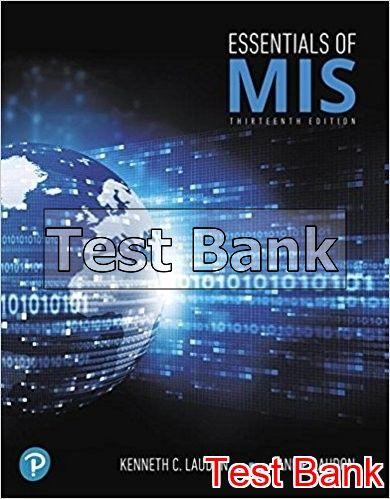
More products digital (pdf, epub, mobi) instant download maybe you interests ...

Essentials of MIS 13th Edition laudon Solutions Manual
https://testbankfan.com/product/essentials-of-mis-13th-editionlaudon-solutions-manual/
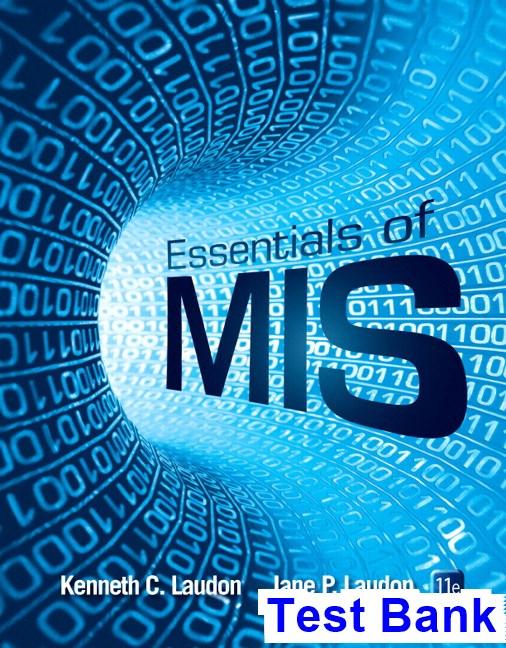
Essentials of MIS 11th Edition Laudon Test Bank
https://testbankfan.com/product/essentials-of-mis-11th-editionlaudon-test-bank/
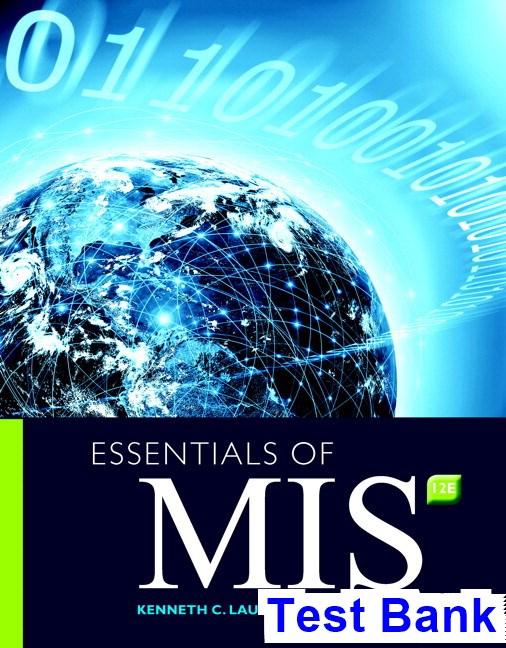
Essentials of MIS 12th Edition Laudon Test Bank
https://testbankfan.com/product/essentials-of-mis-12th-editionlaudon-test-bank/
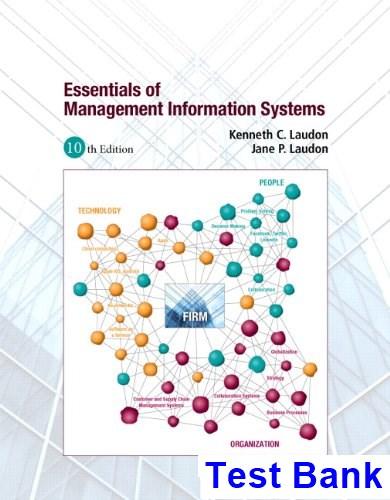
Essentials of MIS 10th Edition Laudon Test Bank
https://testbankfan.com/product/essentials-of-mis-10th-editionlaudon-test-bank/

Essentials of MIS Global 11th Edition Laudon Test Bank
https://testbankfan.com/product/essentials-of-mis-global-11thedition-laudon-test-bank/
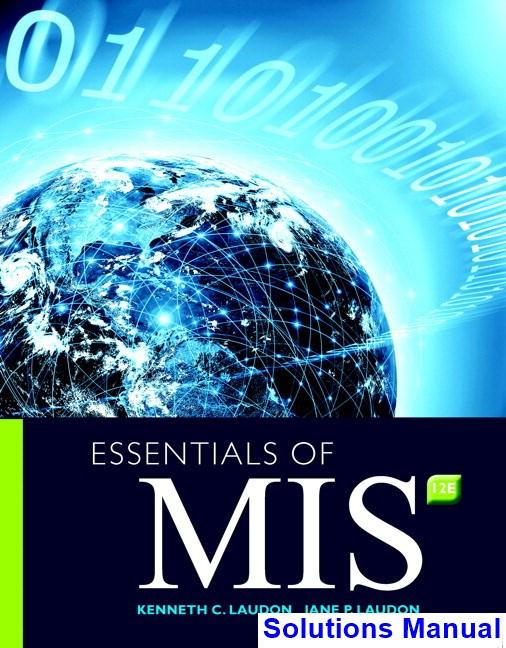
Essentials of MIS 12th Edition Laudon Solutions Manual
https://testbankfan.com/product/essentials-of-mis-12th-editionlaudon-solutions-manual/

Essentials of MIS 10th Edition Laudon Solutions Manual
https://testbankfan.com/product/essentials-of-mis-10th-editionlaudon-solutions-manual/
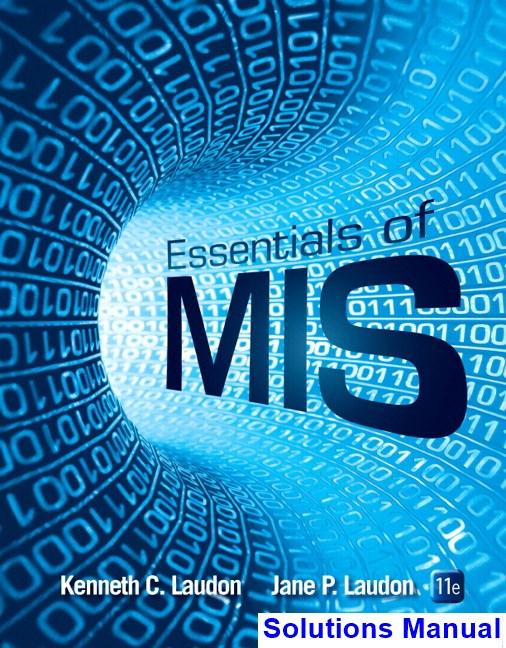
Essentials of MIS 11th Edition Laudon Solutions Manual
https://testbankfan.com/product/essentials-of-mis-11th-editionlaudon-solutions-manual/

Essentials of Management Information Systems 10th Edition Laudon Test Bank
https://testbankfan.com/product/essentials-of-managementinformation-systems-10th-edition-laudon-test-bank/
Essentials of MIS, 13e (Laudon/Laudon)
Chapter 6 Foundations of Business Intelligence: Databases and Information Management
1) From your reading of the chapter-opening case study, the Charlotte Hornets implemented a data warehouse in order to solve which of the following problems?
A) Online ticket sales were falling.
B) There were too many sources of data.
C) The entities and attributes of customer records were poorly organized.
D) There was too much unorganized customer data for decision makers to digest.
E) The team's computer hardware was outdated.
Answer: D
Difficulty: 2: Moderate
AACSB: Analytical Thinking
LO: 6-1: What is a database and how does a relational database organize data?
2) In a business relational database, tables contain:
A) one table for each entity.
B) relations among entities.
C) bytes.
D) three-dimensional relations.
E) links to other tables.
Answer: A
Difficulty: 2: Moderate
AACSB: Analytical Thinking
LO: 6-1: What is a database and how does a relational database organize data?
3) Which of the following best illustrates the relationship between entities and attributes?
A) The entity CUSTOMER with the attribute PRODUCT
B) The entity CUSTOMER with the attribute ADDRESS
C) The entity PRODUCT with the attribute PURCHASE
D) The entity PRODUCT with the attribute CUSTOMER
E) The entity ADDRESS with the attribute CUSTOMER
Answer: B
Difficulty: 2: Moderate
AACSB: Analytical Thinking
LO: 6-1: What is a database and how does a relational database organize data?
4) Which of the following is the type of logical database model that treats data as if they were stored in two-dimensional tables?
A) Two-tiered DBMS
B) Pre-digital DBMS
C) Open source DBMS
D) Hierarchical DBMS
E) Relational DBMS
Answer: E
Difficulty: 2: Moderate
AACSB: Application of Knowledge
LO: 6-1: What is a database and how does a relational database organize data?
5) What are the relationships that the relational database is named for?
A) Relationships between rows and columns
B) Relationships between entities
C) Relationships between fields and records
D) Relationships between databases
E) Relationships between attributes
Answer: B
Difficulty: 2: Moderate
AACSB: Information Technology
LO: 6-1: What is a database and how does a relational database organize data?
6) A characteristic or quality describing an entity is called a(n):
A) field.
B) tuple.
C) key field.
D) attribute.
E) table.
Answer: D
Difficulty: 1: Easy
AACSB: Application of Knowledge
LO: 6-1: What is a database and how does a relational database organize data?
7) The most basic business database is comprised of:
A) three tables: for suppliers, parts, and sales.
B) four tables: for customers, suppliers, parts, and sales.
C) four tables: for customers, suppliers, sales, and employees.
D) five tables: for customers, employees, suppliers, parts, and sales.
E) attributes instead of tables.
Answer: D
Difficulty: 3: Challenging
AACSB: Analytical Thinking
LO: 6-1: What is a database and how does a relational database organize data?
8) In a table for customers, the information about a single customer would reside in a single: A) field.
B) entity.
C) column.
D) table.
E) row.
Answer: E
Difficulty: 2: Moderate
AACSB: Application of Knowledge
LO: 6-1: What is a database and how does a relational database organize data?
9) In a relational database, a record is also called a(n):
A) tuple.
B) key field.
C) entity.
D) field.
E) table.
Answer: A
Difficulty: 2: Moderate
AACSB: Application of Knowledge
LO: 6-1: What is a database and how does a relational database organize data?
10) A field identified in a table as holding the unique identifier of the table's records is called the:
A) primary key.
B) key field.
C) primary field.
D) foreign key.
E) identifying field.
Answer: A
Difficulty: 2: Moderate
AACSB: Application of Knowledge
LO: 6-1: What is a database and how does a relational database organize data?
11) A field identified in a record as holding the unique identifier for that record is called the:
A) primary key.
B) key field.
C) primary field.
D) foreign key.
E) identifying field.
Answer: B
Difficulty: 2: Moderate
AACSB: Application of Knowledge
LO: 6-1: What is a database and how does a relational database organize data?
12) A schematic of the entire database that describes the relationships in a database is called a(n):
A) data dictionary.
B) intersection relationship diagram.
C) field key diagram.
D) data definition diagram.
E) entity-relationship diagram.
Answer: E
Difficulty: 2: Moderate
AACSB: Application of Knowledge
LO: 6-1: What is a database and how does a relational database organize data?
13) A one-to-one relationship between two entities is symbolized in a diagram by a line that ends:
A) in two short marks.
B) in one short mark.
C) with a crow's foot.
D) with a crow's foot topped by a short mark.
E) with a crow's foot topped by two short marks.
Answer: A
Difficulty: 3: Challenging
AACSB: Application of Knowledge
LO: 6-1: What is a database and how does a relational database organize data?
14) A one-to-many relationship between two entities is symbolized in a diagram by a line that ends:
A) in two short marks.
B) in one short mark.
C) with a crow's foot.
D) with a crow's foot preceded by a short mark.
E) in three short marks.
Answer: D
Difficulty: 3: Challenging
AACSB: Application of Knowledge
LO: 6-1: What is a database and how does a relational database organize data?
15) A table that links two tables that have a many-to-many relationship is often called a(n):
A) derived table.
B) intersection relation.
C) foreign table.
D) entity-relationship table.
E) derived relation.
Answer: B
Difficulty: 3: Challenging
AACSB: Application of Knowledge
LO: 6-1: What is a database and how does a relational database organize data?
16) The process of streamlining data to minimize redundancy and awkward many-to-many relationships is called:
A) normalization.
B) data scrubbing.
C) data cleansing.
D) data administration.
E) data management.
Answer: A
Difficulty: 2: Moderate
AACSB: Information Technology
LO: 6-1: What is a database and how does a relational database organize data?
17) Which of the following best describes the importance of creating an accurate data model for your business's database?
A) It is not essential, as the data model itself is modified by the database continuously.
B) It is critical, as without one, your data may be inaccurate, incomplete, or difficult to retrieve.
C) It is essential, as table relationships cannot be created without an accurate data model.
D) It is somewhat important, as the type of data model will define what kinds of data will be stored.
E) It is unnecessary, as a well-designed database should not require one.
Answer: B
Difficulty: 3: Challenging
AACSB: Information Technology
LO: 6-1: What is a database and how does a relational database organize data?
18) You are working in the IT department of a small paper supply company and planning a new database that monitors employee benefits and productivity. What would be the relationship you need to establish between Employee_ID in the Employee table and Parking_spot_number in the Perks table?
A) One-to-many
B) One-to-one
C) Many-to-many
D) Many-to-one
E) One-to-all
Answer: B
Difficulty: 2: Moderate
AACSB: Information Technology
LO: 6-1: What is a database and how does a relational database organize data?
19) As described in the chapter case, the Charlotte Hornets used a ________ to consolidate fan data from multiple sources.
A) database management system
B) relational database
C) data warehouse
D) data model
E) fan management system
Answer: C
Difficulty: 3: Challenging
AACSB: Information Technology
LO: 6-1: What is a database and how does a relational database organize data?
20) The smallest unit of data a computer can handle is called a:
A) file.
B) record.
C) field.
D) byte.
E) bit.
Answer: E
Difficulty: 1: Easy
AACSB: Information Technology
LO: 6-1: What is a database and how does a relational database organize data?
21) A grouping of characters into a word, a group of words, or a complete number is called a tuple
Answer: FALSE
Difficulty: 1: Easy
AACSB: Information Technology
LO: 6-1: What is a database and how does a relational database organize data?
22) Every record in a file must contain at least one key field.
Answer: TRUE
Difficulty: 1: Easy
AACSB: Information Technology
LO: 6-1: What is a database and how does a relational database organize data?
23) A foreign key is a field that links to a separate table.
Answer: TRUE
Difficulty: 2: Moderate
AACSB: Information Technology
LO: 6-1: What is a database and how does a relational database organize data?
24) A small publishing company that you work for would like to develop a database that keeps track of the contracts that authors and publishers sign before starting a book. What fields do you anticipate needing for this database? Identify at least seven fields. Which of these fields might be in use in other databases within the firm?
Answer: Author first name, author last name, author address, agent name, agent address, title of book, book ISBN, date of contract, amount of money, payment schedule, date contract ends. Other databases might be an author database (author names, address, and agent details), a book title database (title and ISBN of book), and financial database (payments made).
Difficulty: 2: Moderate
AACSB: Information Technology; Written and Oral Communication
LO: 6-1: What is a database and how does a relational database organize data?
25) What types of relationships are possible in a relational database? Describe and give an example of each.
Answer: There are three types of relationships: one-to-one, one-to-many, and many-to-many. A one-to-one relationship occurs when each record in one table has only one related record in a second table. An example might be a table of salespeople and a separate table of company cars. Each salesperson can only have one car, or be related to the one car in the database. A one-tomany relationship occurs when a record in one table has many related records in a second table. An example might be a table of salespeople and clients. Each salesperson may have several clients. A many-to-many relationship occurs when records in one table have many related records in a second table, and the records in the second table have many related records in the first table. An example might be a clients table and a products table. Clients may buy more than one product, and products are sold to more than one client.
Difficulty: 3: Challenging
AACSB: Information Technology; Written and Oral Communication
LO: 6-1: What is a database and how does a relational database organize data?
26) The small publishing company you work for wants to create a new database for storing information about all of their author contracts. What difficulties do you anticipate?
Answer: Data accuracy when the new data is input, establishing a good data model, determining which data is important and anticipating what the possible uses for the data will be, beyond looking up contract information, technical difficulties linking this system to existing systems, new business processes for data input and handling, and contracts management, determining how end users will use the data, making data definitions consistent with other databases, what methods to use to cleanse the data.
Difficulty: 2: Moderate
AACSB: Information Technology; Written and Oral Communication
LO: 6-1: What is a database and how does a relational database organize data?
27) A DBMS makes the:
A) relational database available for different analytical views.
B) logical database available for different analytical views.
C) physical database available for different relational views.
D) relational database available for different physical views.
E) physical database available for different logical views.
Answer: E
Difficulty: 2: Moderate
AACSB: Information Technology
LO: 6-2: What are the principles of a database management system?
28) The logical view of a database:
A) shows how data are organized and structured on the storage media.
B) presents an entry screen to the user.
C) allows the creation of supplementary reports.
D) presents data as they would be perceived by end users.
E) shows the relationships between entities and attributes.
Answer: D
Difficulty: 2: Moderate
AACSB: Information Technology
LO: 6-2: What are the principles of a database management system?
29) Which of the following allows users to add, change, delete, or retrieve data in a database?
A) Attribute generation
B) Report generation tools
C) Data dictionary
D) Query wizard tool
E) Data manipulation language
Answer: E
Difficulty: 1: Easy
AACSB: Information Technology
LO: 6-2: What are the principles of a database management system?
30) In a relational database, the three basic operations used to develop useful sets of data are:
A) select, project, and where.
B) select, join, and where.
C) select, project, and join.
D) select, from, and join.
E) who, what, and where.
Answer: C
Difficulty: 1: Easy
AACSB: Information Technology
LO: 6-2: What are the principles of a database management system?
31) The select operation:
A) combines relational tables to provide the user with more information than is otherwise available.
B) creates a subset consisting of columns in a table.
C) identifies the table from which the columns will be selected.
D) creates a subset consisting of all records in the file that meet stated criteria.
E) specifies the content of the database.
Answer: D
Difficulty: 2: Moderate
AACSB: Information Technology
LO: 6-2: What are the principles of a database management system?
32) The project operation:
A) combines relational tables to provide the user with more information than is otherwise available.
B) creates a subset consisting of columns in a table.
C) organizes elements into segments.
D) identifies the table from which the columns will be selected.
E) stores definitions of data elements.
Answer: B
Difficulty: 2: Moderate
AACSB: Information Technology
LO: 6-2: What are the principles of a database management system?
33) Which of the following is an automated or manual file that stores information about data elements and data characteristics such as usage, physical representation, ownership, authorization, and security?
A) Referential integrity module
B) Data definition diagram
C) Entity-relationship diagram
D) Relationship dictionary
E) Data dictionary
Answer: E
Difficulty: 1: Easy
AACSB: Information Technology
LO: 6-2: What are the principles of a database management system?
34) Which of the following is the most prominent data manipulation language today?
A) Access
B) DB2
C) SQL
D) Crystal Reports
E) Hadoop
Answer: C
Difficulty: 1: Easy
AACSB: Information Technology
LO: 6-2: What are the principles of a database management system?
35) Non-relational databases:
A) store information in an unstructured format.
B) use rows and columns to organize data.
C) are used to store structured and unstructured data.
D) are used to store low volumes of transactional data.
E) use database-mapping to normalize relations.
Answer: C
Difficulty: 2: Moderate
AACSB: Information Technology
LO: 6-2: What are the principles of a database management system?
36) DBMS typically include report-generating tools in order to:
A) retrieve and display data.
B) display data in tables.
C) display data in graphs.
D) perform predictive analysis.
E) display data in an easier-to-read-format.
Answer: E
Difficulty: 2: Moderate
AACSB: Information Technology
LO: 6-2: What are the principles of a database management system?
37) Both Oracle and Microsoft Access use SQL to retrieve information from a database. Answer: TRUE
Difficulty: 1: Easy
AACSB: Information Technology
LO: 6-2: What are the principles of a database management system?
38) DBMS simplify how end users work with databases by separating the logical and physical views of the data.
Answer: TRUE
Difficulty: 1: Easy
AACSB: Information Technology
LO: 6-2: What are the principles of a database management system?
39) Microsoft Access is a database management system for large mainframes computers. Answer: FALSE
Difficulty: 1: Easy
AACSB: Information Technology
LO: 6-2: What are the principles of a database management system?
40) A logical view of data shows data as it is organized on the storage media.
Answer: FALSE
Difficulty: 1: Easy
AACSB: Information Technology
LO: 6-2: What are the principles of a database management system?
41) The select operation in a relational database joins records from different tables.
Answer: FALSE
Difficulty: 1: Easy
AACSB: Information Technology
LO: 6-2: What are the principles of a database management system?
42) Identify and describe the three basic operations used to extract useful sets of data from a relational database?
Answer: The select operation creates a subset consisting of all records (rows) in the table that meet stated criteria. The join operation combines relational tables to provide the user with more information than is available in individual tables. The project operation creates a subset consisting of columns in a table, permitting the user to create new tables that contain only the information required.
Difficulty: 2: Moderate
AACSB: Information Technology; Written and Oral Communication
LO: 6-2: What are the principles of a database management system?
43) Describe the process of querying and reporting in a database using DBMS.
Answer: DBMS include tools for accessing and manipulating information in databases. A data manipulation language is used to handle data in the database adding, changing, deleting, and retrieving data. Structured Query Language (SQL) is the most common data manipulation language in use today. DBMS also include the ability to generate reports to display information in a more accessible format using a report generator.
Difficulty: 3: Challenging
AACSB: Application of Knowledge; Written and Oral Communication
LO: 6-2: What are the principles of a database management system?
44) What are some of the benefits of using the cloud as a database platform?
Answer: Cloud-based data management services are ideal for smaller to medium-sized businesses looking to establish database capabilities without paying for expensive in-house database products. Companies can use public cloud-based services or they can use a private cloud to share hardware and software between users, reducing the number of servers, DBMS, and storage devices required.
Difficulty: 1: Easy
AACSB: Application of Knowledge; Written and Oral Communication
LO: 6-2: What are the principles of a database management system?
45) MongoDB and SimpleDB are both examples of:
A) open source databases.
B) SQL databases.
C) NoSQL databases.
D) cloud databases.
E) big data databases.
Answer: C
Difficulty: 3: Challenging
AACSB: Information Technology
LO: 6-2: What are the principles of a database management system?
46) A ________ is a repository for raw unstructured data or structured data that for the most part have not yet been analyzed.
A) data mart
B) data warehouse
C) dashboard
D) data lake
E) relational DBMS
Answer: D
Difficulty: 2: Moderate
AACSB: Information Technology
LO: 6-3: What are the principal tools and technologies for accessing information from databases to improve business performance and decision making?
47) In clustering, a data mining tool will find:
A) new groupings within data.
B) related predictions from existing values.
C) several events grouped by time.
D) new associations.
E) forecasts for future events.
Answer: A
Difficulty: 2: Moderate
AACSB: Information Technology
LO: 6-3: What are the principal tools and technologies for accessing information from databases to improve business performance and decision making?
48) Big data refers to any database that:
A) contains more than one petabyte of data.
B) discovers patterns in data.
C) has a large volume and variety of data.
D) includes data from thousands of websites.
E) stores data in rows and columns.
Answer: C
Difficulty: 2: Moderate
AACSB: Information Technology
LO: 6-3: What are the principal tools and technologies for accessing information from databases to improve business performance and decision making?
49) Data mining is more ________ than OLAP.
A) data-focused
B) multidimensional
C) query oriented
D) discovery driven
E) streamlined
Answer: D
Difficulty: 2: Moderate
AACSB: Information Technology
LO: 6-3: What are the principal tools and technologies for accessing information from databases to improve business performance and decision making?
50) All of the following are tools or technologies for extracting information from unstructured data sets except:
A) sentiment analysis software.
B) SQL queries.
C) Hadoop.
D) a non-relational DBMS.
E) text mining.
Answer: B
Difficulty: 2: Moderate
AACSB: Information Technology
LO: 6-3: What are the principal tools and technologies for accessing information from databases to improve business performance and decision making?
51) Which of the following database types would be best suited for storing multimedia?
A) SQL DBMS
B) Open source DBMS
C) Non-relational DBMS
D) Cloud-based database
E) NoSQL DBMS.
Answer: C
Difficulty: 3: Challenging
AACSB: Information Technology
LO: 6-3: What are the principal tools and technologies for accessing information from databases to improve business performance and decision making?
52) Pre-configured hardware-software systems that use both relational and non-relational technology optimized for analyzing large data sets are referred to as:
A) hybrid DBMS.
B) Hadoop.
C) BI.
D) analytic platforms.
E) data marts.
Answer: D
Difficulty: 2: Moderate
AACSB: Information Technology
LO: 6-3: What are the principal tools and technologies for accessing information from databases to improve business performance and decision making?
53) Which of the following statements about data warehouses is not true?
A) They store supply data to be used across the enterprise for management analysis and decision making.
B) Data warehouse systems provide a range of ad hoc and standardized query tools, analytical tools, and graphical reporting facilities.
C) They may include data from website transactions.
D) Data warehouse systems provide easy-to-use tools for managers to easily update data.
E) Data warehouses make data available for anyone to access as needed.
Answer: D
Difficulty: 3: Challenging
AACSB: Information Technology
LO: 6-3: What are the principal tools and technologies for accessing information from databases to improve business performance and decision making?
54) A data mart usually can be constructed more rapidly and at lower cost than a data warehouse because:
A) it typically focuses on a single subject area or line of business.
B) all the information is historical.
C) it uses a web interface.
D) all of the information belongs to a single company.
E) it is open-source.
Answer: A
Difficulty: 3: Challenging
AACSB: Information Technology
LO: 6-3: What are the principal tools and technologies for accessing information from databases to improve business performance and decision making?
55) Capabilities and tools to manage and analyze large quantities and different types of data from multiple sources are collectively known as:
A) DSS.
B) business intelligence infrastructure.
C) OLAP.
D) data mining.
E) in-memory computing.
Answer: B
Difficulty: 2: Moderate
AACSB: Information Technology
LO: 6-3: What are the principal tools and technologies for accessing information from databases to improve business performance and decision making?
56) Which of the following enables users to view the same data in different ways using multiple dimensions?
A) Hadoop
B) SQL
C) Big data
D) Data mining
E) OLAP
Answer: E
Difficulty: 2: Moderate
AACSB: Information Technology
LO: 6-3: What are the principal tools and technologies for accessing information from databases to improve business performance and decision making?
57) OLAP is a tool that enables users to:
A) obtain online answers to ad hoc questions in a rapid amount of time.
B) view both logical and physical views of data.
C) quickly diagram data relationships.
D) normalize data.
E) find hidden patterns in large databases.
Answer: A
Difficulty: 2: Moderate
AACSB: Information Technology
LO: 6-3: What are the principal tools and technologies for accessing information from databases to improve business performance and decision making?
Another random document with no related content on Scribd:

























